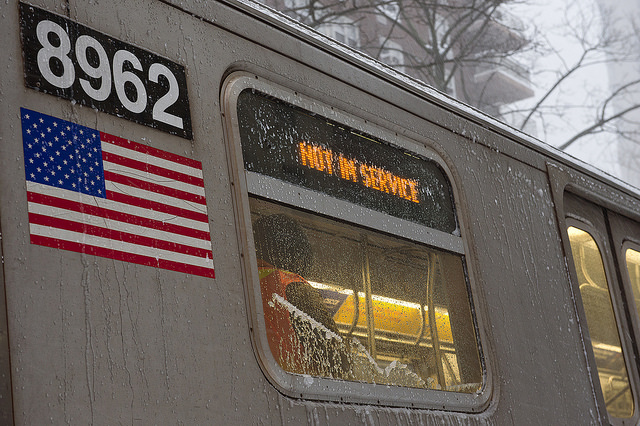
Out of service (photo: MTA/Patrick Cashin)
The denizens of Williamsburg and Bushwick have responded to news of potential multiyear L train closures with a mix of shock, despair, and irritation. People are talking through the alternatives: taking the G, J, and M trains; boarding the East River Ferry; or even (gasp!) riding the bus. Quite likely Williamsburgers will also summon a swarm of UberPools and Lyft Lines unlike any seen in our time.
Hysterics aside, it’s unlikely that the MTA would do a full, year-long double-tube shutdown. The most plausible plan is a long series of “nights and weekends” shutdowns for tube repairs, with the possibility of a brief total closure of both tubes to finish them “Fastrak”-style while rehabs of the 1st Avenue and Bedford stations and additional electrical substations are built. The latter service upgrades, which would permanently boost the line’s peak-hour capacity by 10 percent (a big deal for a subway line often at “crush” capacity during rush hour), depend on the timely success of Senator Chuck Schumer’s request to expedite federal funding. Nothing is certain until the upgrade funding comes through, but some Sandy-related stretch of nights-and-weekends closures is sure to come, as the MTA’s initial bid requests describe a contract lasting about 40 months.
If the MTA does indeed briefly close both tunnels—or even just one at a time—what should be done to limit the carnage? First, carpool restrictions (HOV-2, or even HOV-3) on the Williamsburg Bridge during train closures—just like during transit strikes and natural disasters. Previous nights-and-weekends closures of the L have brought “Carmageddon” to the bridge, especially during UberPool and Lyft Line promotions. Ensuring that solo drivers don’t hog every lane is a surefire way to keep everyone moving.
I personally remember the bridge congestion during the UberPool $2.75-a-ride L train closure special, as it was both the first time I shared an UberPool and the first time I rode with a carsick middle-aged woman being ill out the back window into the East River.
So to minimize the stop-and-go, nausea-inducing congestion—and maximize the potential efficiency of ridesharing services—the city should cooperate with the MTA in implementing HOV restrictions on the bridge, and even dedicating a lane to shuttle buses and the B39. It’s not at all radical to take away a car lane for more efficient transportation modes: The Williamsburg Bridge was built for streetcars.
This potential L train crisis is a reminder that better transit redundancy plans are needed for high-volume chokepoints, even if they inconvenience a comparatively small number of drivers. A truly radical long-term proposal would involve permanently replacing some car lanes with transit-only lanes and re-opening the abandoned streetcar terminal under Essex Street on the Manhattan side of the bridge. Current proposals include replacing the terminal with an odd subterranean mushroom park.
But if the real estate industry ever gets serious about funding a public-private waterfront streetcar through Williamsburg, perhaps restoring the rail lanes to the old streetcar terminal could be added to the plan. No matter what the MTA decides, the coming L train closures are an opportunity to start getting creative with our transportation systems and our waterfront. Let’s hope at least some of these mitigation proposals get a serious hearing.
***
Alex Armlovich is a policy analyst at the Manhattan Institute. On Twitter @aarmlovi.
***
Have an op-ed idea or submission for Gotham Gazette? Email This email address is being protected from spambots. You need JavaScript enabled to view it.




